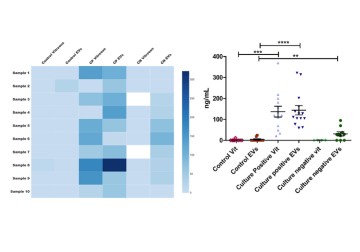In a new study, Dhanwini Rudraprasad, Dr. Joveeta Joseph, and others have assessed the viability of extracellular vesicle proteins complement component 8 - alpha and calpain-2 as diagnostic biomarkers of infectious endophthalmitis.
Endophthalmitis, a possible complication after cataract surgery, can lead to rapid sight-loss. It is characterized by inflammation of the inner eye due to a microbial infection. The infection provokes an intense immune response from the body, leading to inflammation, pus accumulation (hypopyon), and tissue damage in the eye. The quick onset of endophthalmitis (7-9 days) and subsequent vision loss means the window of time for treatment is small. Current diagnostic methods like microbial culture tests are not sensitive enough to detect the etiology of endophthalmitis at an early stage. Culture negativity due to prior treatment often results in false negative results (70% of all endophthalmitis cases at LVPEI). New biomarkers of endophthalmitis that can help quickly and cost-effectively identify endophthalmitis are required to develop improved diagnostic tools.
Extracellular vesicles (EVs) are spherical, lipid-based, nanometer-sized couriers with the promise of acting as biomarkers for disease. EVs transport molecular cargo such as proteins, nucleic acids, and metabolites between cells, facilitating cell-to-cell communication. Some of the EV cargo includes proteins that mark immune response. Such intravesicular proteins could function as biomarkers for infectious diseases like endophthalmitis, especially in cases where the culture test gives a false negative result or takes too long. Previous research from LVPEI found two EV proteins: complement component 8 (C8) complex, responsible for controlling infection, and calpain-2, a pro-inflammatory enzyme, to be differentially expressed in mice and human endophthalmitis models. But does that make them viable biomarkers of the disease?
In a new study published in the journal Translational Vision Science & Technology, Dhanwini Rudraprasad, Dr. Joveeta Joseph, and others from LVPEI take this research forward another step. The team investigated C8-alpha, a subunit of the C8 complex, because in previous research it was the only C8 subunit that was dysregulated exclusively in endophthalmitis models. EVs were extracted from the vitreous—the jelly-like humor inside our eyes—of 35 patients at LVPEI, within a 3-month period. Twenty-five of these patients were diagnosed with endophthalmitis, either confirmed through a culture-positive (CP) result (15 patients) or clinically presumed after a culture-negative (CN) result (10 patients). Ten patients were the control. C8-alpha and calpain-2 levels were analyzed using ELISA, a rapid biochemical diagnostic assay that can detect minuscule levels of proteins.
The EVs in CP samples were 3 times larger in diameter than those in CN and 3.5 times larger than EVs in control samples. Intravesicular C8-alpha level was 39 times higher in CP samples (144 ng/mL) and 8.4 times higher in CN samples (31.2 ng/mL) compared to controls. Notably, intravesicular calpain-2 levels were nearly 5 times lower in CP samples (0.94 ng/mL) and over 6 times lower in CN samples (0.70 ng/mL) versus controls. Lower Calpain-2 levels in infection samples was contrary to previous research and highlights the need for such studies in humans. ELISA testing of C8-alpha was especially effective in diagnosing endophthalmitis in CN samples (over 70% accuracy). The study highlights C8-alpha as a reliable biomarker for diagnosing endophthalmitis and sets the stage for further research.
‘Extracellular vesicles have evolved as a promising entity for developing diagnostic and therapeutic biomarkers due to their involvement in intracellular communication and pathogenesis of diseases,’ remarks Dr. Joveeta Joseph, Head of Microbiology at LVPEI and the corresponding author of this paper. ‘A lot of research in this field is still unexplored. I think we have just touched the tip of the iceberg!’
Citation
Rudraprasad, D., K, V., Nirmal, J., Ali, M. H., & Joseph, J. (2024). Complement Cascade 8 - Alpha and Calpain-2 in Extracellular Vesicles of Human Vitreous as Biomarkers of Infectious Endophthalmitis. Translational Vision Science & Technology, 13(5), 14. https://doi.org/10.1167/tvst.13.5.14
Photo credit: Fig. 3. EV-C8α levels in the study group, Dhanwini et. al.



